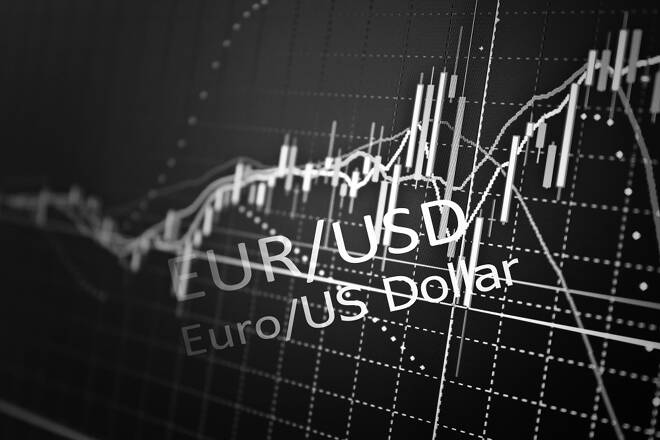Advertisement
Advertisement
The EUR/USD Rebounds as Fast Stochastic Generates Buy Signal
By:
The EUR/USD rebounded to session lows despite as inflation dipped according to the ECB survey and Spanish consumer prices. Thursday’s ECB meeting revealed
The EUR/USD rebounded to session lows despite as inflation dipped according to the ECB survey and Spanish consumer prices. Thursday’s ECB meeting revealed a dovish consensus, as policy was not discussed and the focus was on declining sentiment surveys.
Technicals
The ECB dipped initially but bounced ahead of support near the 200-day moving average at 1.2007. Prices formed a doji day which is an open and a close at the same level which reflects indecision. Resistance is seen near former support which is the breakdown level near which coincides with the 10-day moving average at 1.2257. The fast stochastic has generated a crossover buy signal in oversold territory which points to a rebound. Momentum as reflected by the MACD remains negative.
ECB survey shows inflation forecasts have been cut back
The ECB’s latest survey of professional forecasters shows that inflation expectations for this year have been left unchanged at 1.5%, but forecasts for 2019 and 2020 have been shaved by 0.1 percentage points to 1.6% and 1.7% respectively. This would suggest that even in 2020 the headline rate will be a tad below what the ECB would like to see. The longer term inflation outlook has remained unchanged at 1.9%, so no sign of a loss of confidence in the ECB’s ability to bring inflation higher. The growth forecast for this year was left unchanged at 2.4%, the forecast for 2019 was confirmed at 2.0% and the forecast for 2020 was cut back to 2020.
ECB’s Nowotny said to have pushed for policy discussion
While Draghi said in Thursday’s press conference that monetary policy wasn’t discussed. He reportedly got some support, but the majority deferred to Draghi who apparently thought the time for a firm commitment to an end date for net asset purchases hasn’t come yet. Still with the number of dissenters apparently growing, and Nowotny suggesting recently that there is an argument for moving “perhaps a bit faster” with policy normalisation in order “to have some room for manoeuvre, if we should see some deterioration in the economic condition”, the ECB may already move in June, rather than July.
Eurozone ESI economic confidence held steady
Eurozone ESI economic confidence held steady at 112.7, with the March number revised slightly higher from 112.6 reported initially. Expectations had been for another dip in the reading and the consensus was 112.0, so this is a much better than anticipated number, with the breakdown showing that industrial confidence improved to 7.1 from 7.0 and the March number revised up from 6.4. Services confidence meanwhile came in much weaker than expected at 14.9, while March was revised down to 15.9 from 16.3 reported initially. Mixed messages then, but some indication that special factors indeed played a role in the weaker than expected data over the last couple of month. As Draghi said we will have to wait for more data to clarify if the Eurozone is experiencing a welcomed slowdown from unusually strong growth numbers, or if a bigger correction is underway.
UK preliminary Q1 GDP disappointed
UK preliminary Q1 GDP disappointed with growth of just 0.1% the lowest seen since Q4 2012, falling from 0.4% growth in the previous quarter. The median forecast had been for 0.3% growth. A sharp contraction in construction activity was responsible for most of the slowdown, with the sector declining by 3.3% quarter over quarter. However, the ONS stats office said that the impact of snow on output over the quarter was “relatively small” and that soft growth in part “reflects pockets of weakness more broadly across the country.”
German jobless rate held steady
German jobless rate held steady at 5.3% in April, with total numbers down -7K. A slight disappointment compared to consensus expectations, but actually a tad better than we predicted. The earlier timing of Easter will have prompted services and holiday related hiring in March, rather than April, so that March number was likely above trend, the April reading slightly lower.
Spanish growth held up, inflation dipped
Spanish data showed a very different picture from the French numbers earlier, with GDP growth actually holding steady at 0.7% quarter over quarter in Q1, unchanged from Q4, although the annual rate actually fell back to 1.9% year over year from 3.1% year over year in the previous quarter.
About the Author
David Beckerauthor
David Becker focuses his attention on various consulting and portfolio management activities at Fortuity LLC, where he currently provides oversight for a multimillion-dollar portfolio consisting of commodities, debt, equities, real estate, and more.
Did you find this article useful?
Latest news and analysis
Advertisement
